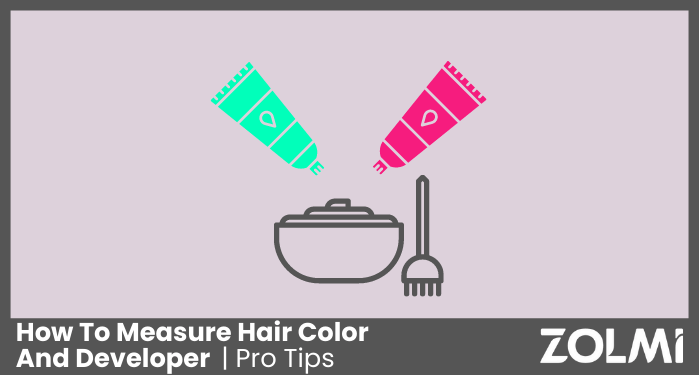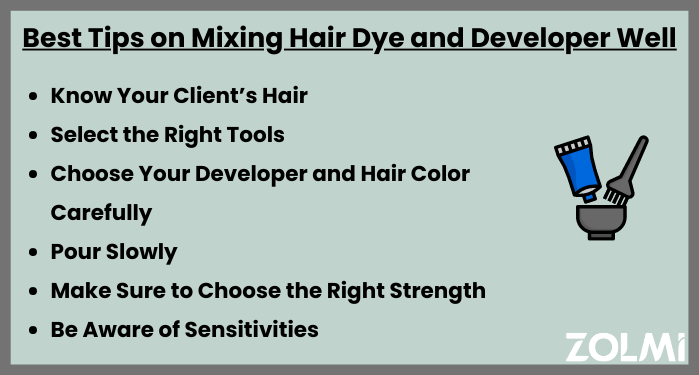How To Measure Hair Color And Developer in 2024 | Pro Tips


Learning how to measure hair color and developer is an essential skill- too much or not enough dye can mean poor results and wasted product. So, how do the pros do it? Let’s find out.
In this article, we’ll take a look at how to get the right ratio of dye and developer, tips on mixing hair color as well as how to boost your color management and reduce or eliminate waste.
There are a couple of different techniques that colorists will use to measure their dye and developer, and trust me when I tell you that none of these involve guesswork.
If you don’t have the correct ratio, you can completely ruin a batch of hair coloring, or at the very least you’ll end up with inconsistent results. Let’s take a look at some pro tips for measuring hair color.
People often wonder how to measure hair color from a tube, and sometimes it can be as easy as checking the tube (but not always).
Sometimes, getting your desired color is as easy as checking the packaging- this is often the case when clients select a straightforward color right out of your sample book.
Check the packaging- measurement marks should be easy to locate on your hair color tubes and will help you get the exact amounts each formula calls for. If you use the same brand every time, this is easy. If you’re working with different products, you’ll want to be extra careful here.
Of course, it never hurts to double-check before you start mixing- you don’t want to end up with too much hair dye and wasted product… which leads us to our next point.
To learn more please check out our post on Hair Color Consultation Questions.
Whether you’re learning how to measure 2 oz of hair developer or you’re a seasoned pro creating complex mixtures in multiple shades, a simple kitchen scale is your best friend.
This is especially useful when your packages lack markings or you just want to be sure that you’ve got everything right- measuring weights will help you get the same amount, every time (remember how much clients love consistency).
When using your scale, be sure to reset it to zero after placing the empty bowl or container on it, then carefully record your weights for later use. After you’re done, transfer the contents to a mixing bowl and get started.
If you’re wondering how to measure hair dye without a scale, then you’ll need some measuring cups. Make sure that they’re plastic, not metal.
You can use a measuring cup to measure your color and developer before mixing. You can use two separate cups or a single one that you clean out between uses.
One thing to be careful of is how much hair color or developer gets left behind- make sure you scarpe out every bit from your measuring cups into your mixing bowl when you’re done- you want to have the exact amount each formula calls for.
We also recommend you to check out our post on Salon Inventory Management.
Do they have short hair or long hair? Do they have damage, or has their hair been previously colored? What’s their percentage of gray hair?
Factors like hair length, hair texture and a client’s coloring history will all influence the hair color’s final result and impact the formula you select. The amount of dye and developer that you need will depend on the length of your client’s hair- you may need two boxes or tubes of dye for the longest hair, so make sure to factor that into your service costs, too.
Since metal can cause the hair dye to oxidize, make sure to use a bowl that’s made of plastic, silicone or glass for mixing.
The same goes for your tools- use plastic utensils or silicone whisks to blend everything together- even plastic forks will do in a pinch, but a whisk works best for a smooth blend. A plastic fork will work in a pinch.
And never use your color brushes for mixing. Hair developers or lightening powder can easily get stuck in the bristles and yield inconsistent or clumpy results.
Not all developers are created equal, and there may be situations where you’ll want to use a cream developer or opt for hydrogen peroxide, so it’s important to be familiar with the developer ratio for each and how they behave when mixing.
When you’re measuring out how much 20 volume developer to mix with hair color, take your time. You can always put in more, but it’s nearly impossible to put it back in the bottle once it’s out.
This is especially true if you’re using lightening powder or a clear developer, since those can pour quickly- you don’t want to accidentally overdo it. Pour out a quarter of what you need at a time, checking the measurements as you go. You can always add more dye later.
Unlike box dyes, professional hair color developers come in different strengths (also called “volumes”). These range from level 10 to 40, with 40 being the strongest.
While you may want to use a gentler level on things like root touch ups or small discolorations (level 20 works well for lifting color two shades or so), level 40 is best for high lift colors like bright blonde shades (it can brighten hair four shades or more, so use it carefully).
Peroxide can be irritating, so you may want to stick with cream developers if your client has a sensitive scalp. Ask about any previous reactions to developer or dye before you begin.
Learn more in our post Hair Color Consultation Questions.

To learn more please check out our post on Hair Color Inventory App.
So, what does hair developer do by itself, and why do we use it?
Developers such as hydrogen peroxide help to open up hair cuticles and let color penetrate the hair shaft. Using enough developer also helps to open up the hair cuticle and lift the natural color out, allowing permanent hair dye to show up brighter.
Using a hair developer helps you achieve consistent and lasting changes, but using too much developer can negatively affect results.
Since not all hair dyes contain the same amounts or have the same requirements, knowing how much developer to add when mixing dye can be challenging. You may want to keep a hair color mixing ratio chart handy in the back room for easy reference.
So, how much hair dye and how much developer will you need?
Let’s take a look at the common mixing ratios and what they’re used for:
If you’re coloring hair a single shade that’s close to the natural color, use a 1:1 ratio- these equal proportions will be just enough to help hair colors easily stick to the shaft.
This is also the usual color to developer ratio for gray hair, but if you’re having trouble trying to dye stubborn grays, I’d recommend switching to a 1:1.5 ratio or adding a longer processing time.
If you’re applying a toner or lightening a client’s hair by one or two levels, this ratio will be enough to achieve good results. This also works well on the grown out part of a client’s hair if you’re trying to dye stubborn roots.
This mixture works best when you want to achieve dramatic results and go three or four shades lighter in color. To do this, you’ll also need to use a 30 or 40 volume hair developer. Be careful and make sure that the hair isn’t brittle or damaged, or you’ll just make things worse.
When mixing your formula, how much hydrogen peroxide or cream is too much? Keep in mind that hair developer levels can go too high, as well as two low. If you use too much developer, the hair colors won’t penetrate properly and will look faded or washed out.
Learn how to attract new talent to your salon in our post Hair Colorist Job Description.
When it comes to optimizing your salon and making life easier for your staff and clients, salon software is to “dye” for (pardon the pun).
Using salon software with hair colour app can help you figure out how much dye to use every time (and remember each client’s formulas for the next visit), along with reducing or eliminating product waste. Not only that, but it can make your entire salon process more efficient.
To start, some salon software integrates with your bluetooth scale or a color mix app to help with fast and easy calculations.
You can measure your dye, then save the formula in your client records, using the same formula and any notes again next time for perfect results. You can even save images for reference. If you use a color consultation form, you can save it here and easily send it to clients online.
If you tend to use too much hair color, just re-weigh the color bowl if there is leftover color and adjust your formula for the same amount next time, saving time and product.
And speaking of saving money and time, salon software makes back bar management a breeze, since you can track the amount of dye or product used, then set flexible pricing options based on your usage. You can also keep a close eye on your costs and revenue, streamline your stockroom process and even set certain items to reorder automatically.
And why let a client’s processing time go to waste, when you could be increasing your revenue?
Salon software helps you to optimize your appointments and eliminate downtime by booking in other services. Once you’ve applied the dye and developer, you can schedule other clients while you wait. You can also block off extra time for cleaning or setup, making scheduling easy.
Hair dye is a great way to help a client change or refresh their look quickly, and the results can be subtle, glamorous or downright dramatic. When done right, a good dye job is awesome advertising for your salon.
When learning how to measure hair color and developer, the most important thing to remember is consistency. Always go through the same steps in your measuring and mixing process to avoid mistakes, and keep detailed client records for next time.
Hair color measurement and variation
https://onlinelibrary.wiley.com/doi/abs/10.1002
The effect of hair color on the incorporation of codeine into human hair
https://academic.oup.com/jat/article-abstract
A comparison of macroscopic and microscopic hair color measurements and a quantification of the relationship between hair color and thickness
https://www.cambridge.org/core/journals/microscopy-and-microanalysis/article/comparison